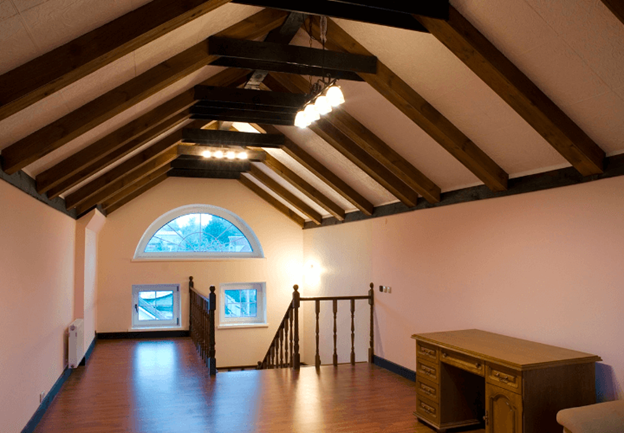Living in an attic can be challenging, especially during summer, spring, and fall. This is because the attic is one of the first spaces affected by mold, mildew, and dampness, causing excess moisture in the air. Excess humidity can be caused by many factors such as poor ventilation, roof leaks, heating sources, and excessive insulation.
Controlling this excess moisture from your attic is crucial for your health and safety. For that, a dehumidifier could be a good solution to control the excess humidity in your attic. This device can automatically control your desired humidity level and continuous drainage without any noise.
In addition, you also can control humidity by insulation, air ceilings, and ventilation of heat sources that keep your room comfortable. Read this article to know more details about how you can control the humidity in your attic.
If you are not sure your attic has a problem with excessive humidity, the best way to check is a hydrometer. This is a little device like a thermometer, but it measures humidity levels rather than temperature.
| Dampness Level | Capacity (Pints per day) |
| Moderately damp | 30 |
| Highly damp | 50 |
| Wet | 70 |
Typically, the ideal humidity level is between 35% and 50%. If it’s much higher than 50%, you should find out the reasons for high humidity, or you can also use a good Dehumidifier for Attic to eliminate the excess moisture.
To keep your attic cooler in the summer, warmer in the winter, and free from damage, you should control the humidity. Below we have described why you need to control the humidity levels in your attic.
In summer, the main concern is heat that can build up under the roof deck and cause your shingles to deteriorate rapidly and shorten life expectancy. Besides, your cooling system needs to work harder to keep your room comfortable due to the high temperatures. For example, when the outside temperature is 90° in summer, the attic temperature can easily reach 120°-150°.
In the winter season, warm and humid air combined with cold outside temperature leads to condensation, making insulation on the cold wood surfaces, chimney surfaces, and metal nail heads ventilation pipes. If kept for extended periods, this moisture can cause wood to rot, brick erosion on the surface of the chimney, and eventually mold growth.
There are lots of reasons for the high humidity in the attic. Below we have pointed out some major reasons for high moisture.
- Additional Insulation: Extra padding in your attic causes condensation of wetness and consequently increases humidity levels.
- Heating Source: Having heating sources surrounding your attic can be one of the major reasons for the high humidity in your attic.
- Roof Leaks: The presence of leakages on your attic roof results in penetration outside humidity into the attic.
- Poor Ventilation: Poor ventilation causes humidity issues because warm and moist air gets trapped in your attic.
Fiberglass and cellulose are two common types of attic insulation. Fiberglass has a good R-value, and it works well in all climates. It dries easily if it gets wet, as it is inorganic and does not support mold growth. On the other hand, cellulose also has a good R-value but is more susceptible to damage from moisture and supports mold growth when wet for a long time.
Along with insulation, you may want to consider air sealing at the same time, as this will be tough to do when the new insulation has been installed. Air sealing means sealing the attic with all potential causes of air leakage. This includes holes in the bath and kitchen fans, outlets, light switches, baseboards, and around chimney chase. When all these areas are sealed with caulk and expanding foam, humidity levels will be controlled.
Proper ventilation will help to reduce heat build-up by solar radiation from the sun. Most attic roofs have shingles that are made of asphalt with ceramic granules. Ceramic helps to repel the sun’s damaging UV rays, but asphalt absorbs a lot of heat that trades into your attic through the shingles, roof deck. Proper ventilation can help circulate the air, reduce heat in the attic and keep down humidity levels.
A radiant barrier is a metallic plate that can reflect bright heat caused by the sun. It can be used below the roofing materials on the attic or inside the room top interior that helps return heat to its source. This will help to barrier the sun heat coming to your attic and remain your room comfortable, keeping humidity level control.
If you still get high humidity, a dehumidifier can remove it. This will help to eliminate moisture from the surrounding environment. Also, a dehumidifier will cool your attic space up to 20 degrees Fahrenheit. Because it helps to get rid of moisture, which is a heat-trapping agent. A dehumidifier will help prevent plastic cracks, mold growth, wood rot in your attic.
A dehumidifier is an ideal device that helps control humidity and solves the mold problem in your attic. It can maintain a constant value of humidity. Also, you can set your desired humidity value, and the dehumidifier will be run until it reaches the level and keeps it stable.
A dehumidifier significantly prevents the formation of mold, dust, and several other allergens inside the attic to maintain a healthy atmosphere. In addition, dehumidifiers run with lower energy costs as it helps the HVAC units run more efficiently and make no noise.
Capacity of the Dehumidifier
The capacity of a dehumidifier means the ability to extract moisture from your room within 24 hours. Typically, standard capacities are 25pints, 50 pints, and 75 pints. The higher the capacity, the more moisture can be extracted at the same time through the dehumidifier. The capacity of the dehumidifier depends on the following factors:
- The size of the attic for which you required a dehumidifier.
- Relative structural dampness.
- The temperature of the surroundings.
If the moisture level of the attic is high, then you have to run the dehumidifier for a long time and must consider the water removal. As every dehumidifier has an internal water storage tank, you have to empty it once the tank gets filled. Most dehumidifiers come with an internal pump; you have to buy one to extract the water if you don’t.
The automatic sensor feature enables the dehumidifier to shut off/on when it reaches the set target. It also helps you to save energy and monitor the level of humidity in the attic. Besides, most dehumidifiers have an auto-reset function that allows the system to reset automatically when the power is restored.
You have to place the dehumidifier on the attic in a position that’s far from any obstructions and dangers. This is because the placement and position of the dehumidifier play a significant role in its efficiency. Ideally, you can place it in the middle of the attic so that the dehumidifier can dehumidify the whole space.
Otherwise, it can be placed near the toilet or a larger bucket if you use the continuous drain feature. Remember that you have to put the dehumidifier at least one foot above the floor and far away from the walls or any object present in the attic. This way, the dehumidifier will not interrupt the airflow inside.
Hopefully, this article has presented you with enough information about how you can control the humidity in your attic. Most professionals advised increasing ventilation if the ventilation is inadequate. However, this may only increase condensation and lower the effectiveness of the insulation. The best solution for controlling humidity is using a dehumidifier that helps to reduce moisture in the attic. But you should figure out the root causes of the problem. If you find any defect, consider insulation, air ceilings, and ventilation as we mentioned above.


